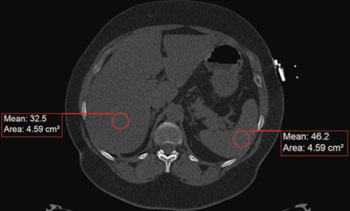Coronary CT Angiography Reveals Link between Coronary Artery Plaque and Liver Disease
By MedImaging International staff writers
Posted on 19 Nov 2014
Researchers using coronary computed tomography angiography (CCTA) imaging have found a close correlation between high-risk coronary artery plaque and a common liver disease. The research revealed that a single CT scan can detect both conditions.Posted on 19 Nov 2014
Earlier research has shown that CCTA can identify high-risk coronary artery plaque, or plaque prone to life-threatening ruptures. For the new study, researchers examined the association between high-risk plaque and non-alcoholic fatty liver disease (NAFLD), a disorder characterized by abnormal liver function that is not associated with excessive alcohol consumption. NAFLD is the most common liver disease, with an estimated prevalence of 20%–30% in the general population.
“As it is known that atherosclerosis is linked to inflammation, our next step was to look for an association of high-risk plaques with other systemic inflammatory conditions such as NAFLD,” said the study’s lead author, Stefan B. Puchner, MD, from Massachusetts General Hospital (MGH) and Harvard Medical School (both based in Boston, MA, USA) and the Medical University of Vienna (Austria). “Interestingly, both pathologies can be detected in a single CT examination.”
The researchers, who published their findings online November 4, 2014, in the journal Radiology, drew patients from a large trial focusing on the use of CCTA in people who had come to the emergency department with acute chest pain. The patients underwent both nonenhanced CT to evaluate coronary calcium, a marker of atherosclerosis, and contrast-enhanced CCTA. Readers assessed the CCTA images for signs of high-risk plaque.
Overall, 182 of the 445 patients in the study (40.9%) had CT evidence of NAFLD. High-risk plaque was seen in 59.3% of patients with NAFLD, compared to only 19% of those without NAFLD. The association between NAFLD and high-risk plaque persisted after adjusting for the extent and severity of coronary atherosclerosis and traditional risk factors.
The results suggest that high-risk plaque and NAFLD are both part of the same systemic disease process, the metabolic syndrome. “The clinical implications could include a wider assessment of NAFLD using the non-contrast cardiac CT scans that are commonly performed prior to the CTA,” he said. “Further, the additional assessment of NAFLD with CT could improve the risk stratification of patients with suspected coronary artery disease, as our results show that the presence of NAFLD is associated with high-risk coronary plaque independent of traditional risk factors and severity of coronary artery disease.”
The researchers plan to extend the study outside of the emergency department setting to see if the results apply to other categories of the general population. They also hope to learn more about why NAFLD is so prevalent among people with advanced high-risk coronary atherosclerosis. One prevailing theory is that both conditions are a consequence of systemic inflammation, an inflammatory state that affects multiple organs and can lead to deadly disorders.
“The aim will be to further investigate and understand, with the help of CCTA, the interplay between advanced atherosclerosis and NAFLD as part of a complex systemic inflammatory condition,” Dr. Puchner concluded.
Related Links:
Massachusetts General Hospital
Medical University of Vienna
















